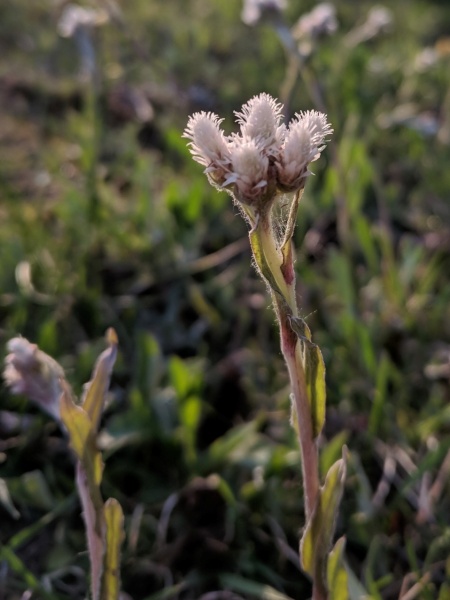
Source: Nate Martineau
Antennaria howellii
Howell's Pussytoes
Antennaire de Howell
Synonyms
small pussytoes
No seeds available for this plant.
We currently accept seeds for this plant
Bloom Colour: White
Bloom Period: May - Jun
Max Height: 1.0 feet
Max Width: 1.0 feet (spreads by rhizome)
Light Condition:
 More than 6 hours of direct sun a day
More than 6 hours of direct sun a day
 More than 2 or 3 hours but less than 6 hours of direct sun a day
Soil conditions:
More than 2 or 3 hours but less than 6 hours of direct sun a day
Soil conditions:
 Tolerates dry soil condition
Tolerates dry soil condition
 More than 6 hours of direct sun a day
More than 6 hours of direct sun a day
 More than 2 or 3 hours but less than 6 hours of direct sun a day
More than 2 or 3 hours but less than 6 hours of direct sun a day
 Tolerates dry soil condition
Tolerates dry soil condition
Lifespan:
Perennial
plants that will that come back year after year
Plant is
dioecious
Need a male and female plant to produce seeds
Gardener Experience:
 Suitable for beginner gardeners
Suitable for beginner gardeners
 Does not spread uncontrollably
Does not spread uncontrollably
 Self-seeding
Self-seeding
 Suitable for beginner gardeners
Suitable for beginner gardeners
 Does not spread uncontrollably
Does not spread uncontrollably
 Self-seeding
Self-seeding
Landscape Uses:
 Suitable for rock gardens
Suitable for rock gardens
 Suitable for container garden
Suitable for container garden
 Suitable for rock gardens
Suitable for rock gardens
 Suitable for container garden
Suitable for container garden
Ecological Benefits:
 Supports pollinators
Supports pollinators
 Butterfly host
Butterfly host
 Supports pollinators
Supports pollinators
 Butterfly host
Butterfly host
Tolerates:
 Deer resistant
Deer resistant
 Rabbit resistant
Rabbit resistant
 Tolerates foot traffic around the plant
Tolerates foot traffic around the plant
 Tolerates juglone conditions
Tolerates juglone conditions
 Tolerates transplantation
Tolerates transplantation
 Deer resistant
Deer resistant
 Rabbit resistant
Rabbit resistant
 Tolerates foot traffic around the plant
Tolerates foot traffic around the plant
 Tolerates juglone conditions
Tolerates juglone conditions
 Tolerates transplantation
Tolerates transplantation
Special Features and Considerations:
 This plant is septic tank safe
This plant is septic tank safe
 This plant is septic tank safe
This plant is septic tank safe
Plant Location
Native to Ottawa region: Yes
Distribution according to VASCAN

Ephemeral
Native
Introduced
Excluded
Extirpated
Doubtful
Absent
Thrives in Ecozones
- Taiga Plains
- Atlantic Maritime
- Taiga Shield
- Boreal Plains
- Montane Cordillera
- Boreal Shield
- Mixed Wood Plains
Ecological Benefits
Butterflies Supported by Antennaria howellii
- Vanessa virginiensis (American Lady)
Specialized Bees Supported by Antennaria howellii
No bee data available for this plant.
Plants that grow in similar conditions, that bloom at the same time.
Complementary Plants
- Antennaria parlinii
Parlin's Pussytoes
Antennaire de Parlin - Fragaria virginiana
Virginia Strawberry
Fraisier des champs - Plantago rugelii
Rugel's Plantain
Plantain de Rugel - Sisyrinchium angustifolium
Narrow-leaved Blue-eyed Grass
Bermudienne à feuilles étroites - Sisyrinchium montanum
Strict Blue-eyed-grass
Bermudienne montagnarde
Substitute For Non-Native Plants
- Convallaria majalis (Lily of the Valley)
- Scilla siberica (Siberian Squill)
- Salvia (Non-Native Sage)
Sowing Information
Download Seed Envelope Labels (PDF)
- Sowing depth: Surface sow
- Sow anytime
- Stratification duration: 0 days
- Self-seeding
Harvesting and Seed Sharing
- Harvest start month: July
- Harvesting indicator:
- Seeds have become fluffy and can be easily removed by shaking on gently pulling off from stem
- Harvesting:
- Use hand to detach from main stem
- Seed viability test:
- No test needed before donating
- Packaging measure: 1 rounded 1/4 teaspoon
- Seed storage:
- Air dry in paper bag or open container, for a few days until crisp
- Shake seeds to move them once in a while to prevent molding
- Cultivar: No, you can donate without knowing the source as there are only straight species
- Harvesting video: Watch here
Toxicity Notes
Inadequate information on toxicity found.


 Canadensis
Canadensis
